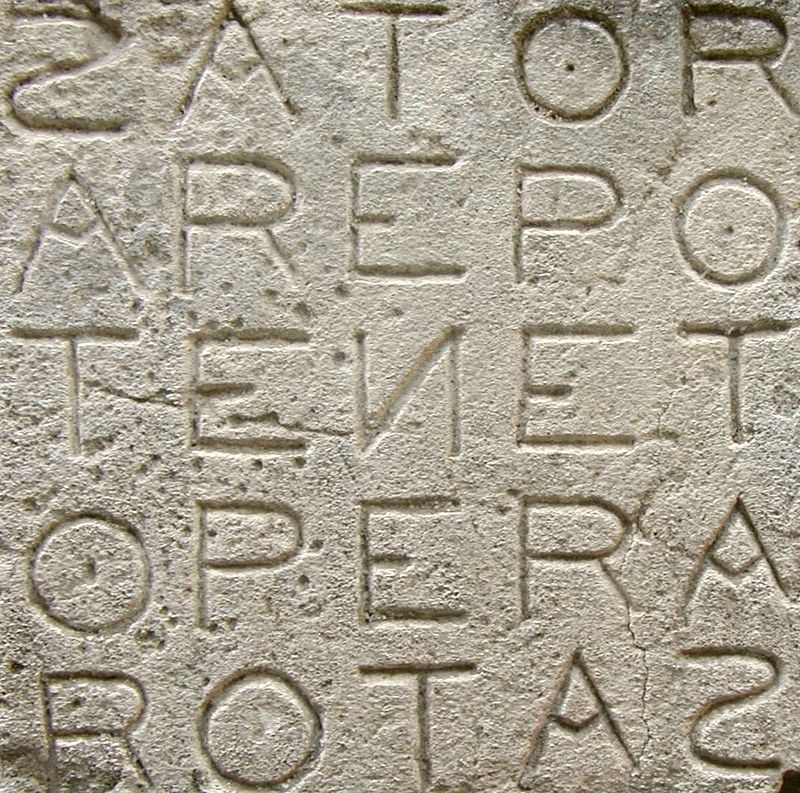
| _S_ | _A_ | _T_ | _O_ | _R_ |
|---|---|---|---|---|
| A | R | E | P | O |
| T | E | N | E | T |
| O | P | E | R | A |
| R | O | T | A | S |
This SATOR-ROTAS word square is a very old magical formula dating from at least the 1st centry c.e. It is also called the "Rotas-Sator square," and its ultimate origin is unknown. Likely, this Latin charm originated during the early Roman empire. It was found as a graffito at the Roman town of Herculaneum, under the vulcanic mud of Vesuvius. It was likewise scratched in the fragments of a plaster wall in a Roman villa at Corinium (modern Cirencester). It has also been found inscribed on ancient drinking vessels.
The words, SATOR AREPO TENET OPERA ROTAS, are written in a square so that they may be read left to right, right to left, top to bottom, or bottom to top.
Perhaps because it is a four-times palindrome, this enigmatic word square has persistently reappeared as a magical or mystical symbol.
The SATOR-ROTAS word square has been found on the pavement outside the church of the Knights of Valetta, Malta, in bibles from the Carolingian period, and the wall of the Duomo of Siena.
Perhaps this magic word square was originally a powerful protection charm, but that speculation is based on the numerous uses ascribed later to it. In the 18th century, it was used as a protection for dairy cattle, as well as a protection against pestillence, sorcery, colic, bad air, and fire. The 19th centry book, Powow, or the Long Lost Friend stated that the SATOR ROTAS word square, written on a plate and tossed into the flames will extinguish the fire. This word square has also been used to remove fevers.
This word square has been carved in wood, stone, plaster, written on parchment and paper, and I once read a folktale in which an American healer murmured it as an incantation.
Scholars over the centuries have argued about the meaning of the words.
Sator is a minor Latin God associated with planting seeds. Rotas is Latin for wheel. The rest of the words could be jibberish--word play designed to make the magic square work. The word, arepo, for example, appeared nowhere else in Latin.
Nevertheless, numerous attempts have been made to unlock a mystical meaning behind the words. One speculation about a translation was "the planter (sator), Arepo, delays (tenet) his works (opera) the wheels (rotas)." Others include:
"The sower creeps, holding the work of the wheel."Lack of easy translation has lead some to believe its magical power relates to the transposition of Sator and Rotas and the balance of the extra letters. Hence, attempts at literal translation will fail.
"Arepo, the sower, leads with his hand [work] the wheels [plow]."
"The sower, Arepo, holds the works of the wheels."
Scholars remain divided on the question of the SATOR ROTAS square’s precise origin and purpose. There have been many speculations on possible esoteric connections via Jewish, Greek, Mithraic, or other pre-Christian sources.
copyright 2008 Myth Woodling
SATOR ROTAS 2021 addition:
It has often been claimed that the SATOR ROTAS square was actually a secret anagram for the Latin PATER NOSTER, aka the “Our Father” or the “Lord’s prayer”, which is the central prayer Christianity which—according to the New Testament—was taught by Jesus to his followers and is found in Matthew 6:9-13 and Luke 11:1-4. Personally, I think that seems a little unlikely.
|
PATER NOSTER, QUI ES IN CAELIS SANCTIFICETUR NOMEN TUUM. ADVENIAT REGNUM TUUM. FIAT VOLUNTAS TUA, SICUT IN CAELO ET TERRA. PANEM NOSTRUM QUOTIDIANUM DA NOBIS HODIE, ET DIMITTE NOBIS DEBITA NOSTRA. ET NOS DIMITTIMUS DEBITORIBUS NOSTRIS. ET NE NOS INDUCAS IN TENTATIONEM, SED LIBERA NOS A MALO. AMEN. |
Does there really seem to be a connection with the SATOR ROTAS square to the Latin Pater Noster?
Ellie Swire wrote, “Whatever their derivation, examples uncovered throughout Europe and beyond indicate the enduring appeal and repurposing of sator squares across shifting geographical and cultural boundaries.”

|
Sator Square, SATOR AREPO TENRT OPERA ROTAS (word square, palindrome) in Oppède (France). The letters S and N are reversed in this image like for an ambigram. M Disdero - Taken at Oppède, Luberon, France, 2003 |
SOURCES:
Ellie Swire, Sator Squares by magdlibs, Magdalene College Libraries, November 19, 2019, accessed February 13, 2021.
2021 addition copyright Myth Woodling